
TECHNICALLY this blog is about Jordan. However, it is widely agreed that Jordan is perhaps the least culturally interesting country in the Arab World. Jordan is a country constructed by the British to reward the loyalty of the Hashemite family during the First World War. They were awarded a small corner of low-populated land north of the Arabian peninsula – far away from their home base in the southern half of the Arabian peninsula. While the Hashemite family has created a safe, stable environment in Jordan, any culture within their country is imported from Lebanon, Palestine, Iraq, Syria, or Saudi Arabia; not one ounce of culture is unique to Jordan. So when my language institute offered a trip to Cairo, I immediately jumped on the opportunity.
As I sit in Amman getting over a pretty bad case of food poisoning, I have decided to showcase the culture, history, and life of the Arab World’s largest country: Egypt.
Cairo dates back to about 14000 years ago, when the ancient Egyptian civilization began to form. However, we usually begin referring to Egyptian history about 5500 years ago when the first written documents were found and the capital – Memphis – was situated approximately at the same spot as modern Cairo. After the fall of the Egyptian empires, Egypt was absorbed into the Greco-Roman world. However, Egypt did not get its next chance to shine until about 900 AD when the Islamic Caliphates began to rule. In 969, the city of Cairo was officially founded by the Fattimids – one of the main Islamic dynasties to rule from Egypt. During the 1100’s, Cairo became a point of interest for Crusaders seeking to consolidate power in the region. They were unable to take the city – now the capital of Egypt – thanks to a ruler named Saladin or Salah ad-din (صلاح الدين). His dynasty – the Ayyubids – and the following Mamluks ruled from Cairo until the Ottomans took control of the city. However, Egypt was able to gain autonomy when Muhammed Ali Pasha (not to be confused with the boxer, who chose his Muslim name in honor of the Egyptian leader) consolidated power in the early 19thcentury; the Ottomans were afraid of Muhammed Ali and let him run the area that was Egypt. This is considered the start of “Modern Egypt” as we know today.
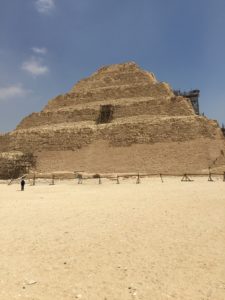
With Cairo’s illustrious history, there are so many monuments and historic sites that display the grandeur of its past. Perhaps the most notable of these monuments are the pyramids. The first pyramid was a sloppily constructed step pyramid in Saqarra, south of present day Cairo. Over the next two hundred years, royal engineers finally sharpened up all the details and built one of the most famous monuments in history – the Great Pyramid at Giza. The steep pyramid is pretty tall and I was a bit overwhelmed to see it so up close (and go inside!). Many people complain about how the Pyramids are not alone in a desert corridor (they are located in Giza, a 4 million person city that compromises of anything west of the Nile). That did not stop me from enjoying the desert around the Pyramids where I rode four-by-fours (the pharaoh’s transportation method of choice) and camels around the area.
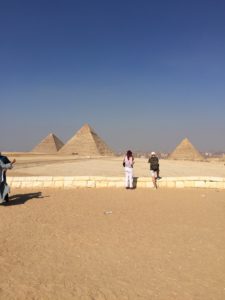
In Cairo proper, the Egyptian Museum houses perhaps the best collection
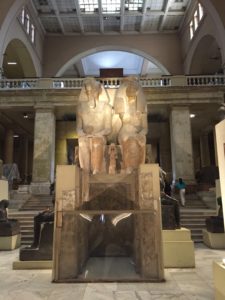
of Egyptian artifacts on the planet. The current building – which the museum will be leaving in 2022 – has no AC stunningly, but the humidity did not stop me from enjoying the wide range of antiquities. The museum overlooks Tahrir Square – an underwhelming traffic circle that served as the center of the Egyptian Revolution in 2011. Seeing Tahrir Square is a reminder that Egypt is still making history to this day.
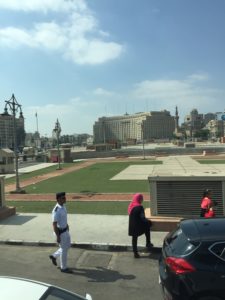
While ancient Egypt is pretty cool, perhaps the most beautiful buildings in Cairo date back to the Islamic Caliphates. “Islamic Cairo” – the unofficial Old Town of Cairo – houses a number of stunning houses, mosques, schools (including Al-Azhar, the oldest Islamic university in the world), shops (centered around the bustling Khan el-Khalili souq), and an intimidating citadel built by Salah al-Din. The architecture is a mix between Fattimid, Ayyubid, and Mamluk buildings, and each one possesses elaborate designs and incredible stone carvings that rival the Alhambra in Spain. I visited two Fattimid Era mosques, and each time I was stunned by the precision of the craftsmanship.




Islamic CairoThe most beautiful mosque in Cairo – in my opinion – was built more recently. Muhammed Ali Pasha built his mosque in the 1820’s and apparently used stones from the outer coating of the Pyramids. Perched on the highest point in the city in Salah al-Din’s castle, I have never seen anything like it. The marble courtyard surrounded by stunning columns and elaborate craftsmanship leads to the mosque proper which is built in the more “modern” style (in an Ottoman style). Words cannot describe the beauty of this building.


Gama’a Muhammed Ali Basha (جمعة محمد علي باشة)Over time, Egypt developed one of the most unique cultures in the Arab world. Egyptian food features far less Levantine food (ie hummus, shwarma, kibbeh), with the main Egyptian dish being koshary. Koshary is essentially carb overload: it is rice, macaroni, lentils, chickpeas, and fried onions finished with tomato sauce and optional garlic vinegar and hot sauce. I ate koshary at the world’s most famous koshary restaurant named Abu Tarek, a three-floored establishment with a décor that can be described as a combination between a New York diner and My Big Fat Greek Wedding. The koshary – after being flavored to your liking with hot sauce and garlic – was a hardy meal, and I think I will adopt it as my carb-meal before the next half marathon I run!

Additionally food in Egypt includes ta’ami, which is often called Egyptian falafel. Unlike it’s Levantine counterpart, it is flat and made with fava beans instead of chick peas. The ta’ami is also significantly spicier than its Levantine cousin. When Egyptians want protein, they have two main specialties. The first is pigeon. These pigeons are not the ones that fly in and out of the subway train, but deliberately farmed like a quail. I did not try any pigeon as I am a pescatarian, but the variety stuffed with rice is favored by everyone. More up my alley is the fish eaten. While in Cairo I stuffed myself with a delicious Egyptian dinner with fried whole shrimp, fried calamari, and barbequed fish while riding a felucca, a boat indigenous to the Nile. I certainly enjoyed myself from a culinary standpoint in Egypt (although I may be paying the price now).

It is impossible to talk about Cairo without talking about the Nile. If you go about seven miles away from the Nile in either Cairo (the east side) or Giza (the west side), you will find yourself in the desert with no trees at all. However, as you move closer and closer to the river, Cairo/Giza becomes green with lots of trees lining the streets. Eventually you hit the river – a lush, tropical wonderland surrounded by hotel high-rises. It is imperative to go on a felucca boat (especially the party ones that blast Arab hits) to the see the Nile (I went twice), and I cannot describe just how green, lush, and beautiful the Nile is. It truly gives life to the country of Egypt.
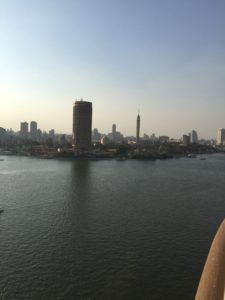
That said, Egypt’s (and specifically Cairo’s) dependence on the Nile means that roughly 20 million people are squished into a 15 mile radius. Every building in Egypt is taller than six stories (in Jordan, none would be taller than 5), and walking the street or driving through the city can be a real challenge. The crowdedness is everywhere in Cairo whether you live on Gezeera in Zamalek (the incredibly bougie part of Cairo on an island in the Nile) or if you live in a slum. Many builders opted to keep the brick frame as the exterior to save money. Many building projects go unfinished, and it seems that every other building is abandoned before completion. The crowdedness and subsequent poverty in Egypt was something I had never truly experienced. One day, we visited a co-op farm growing mangoes (an Egyptian specialty) south of Cairo. The family lived in horrendous conditions, and were even begging for money as we visited them. Amman is the middle class of the Middle East, and I am happy I left the comfy Kingdom of Jordan to experience how the poorer countries live.
One thing I was unable to do was get to talk to a number of Egyptians. There are two main reasons for that. The first is that the Egyptian dialect of spoken Arabic is completely different from the Shami dialect I am learning. Certain letters are pronounced differently, most notably jeem( ج) is pronounced as a g-sound instead of a j-sound (jamea’a جامعة[university] is pronounced gamea’a in Egypt). That said, hearing and learning some Egyptian dialect allowed me to understand the origin many words in fusha (MSA). Fushais a standard form that takes from all forms of spoken Arabic, and because Egypt is the largest Arab country, many of their words feature prominently – enhancing my language education. The other reason I was unable to talk to Egyptians is due to a certain level of restricted free speech. The post-revolution government in Egypt – headed by Abdel Fatteh el-Sisi – has become very authoritative; you see far more Sisi propaganda in Cairo than you would ever see for King Abdullah in Amman. That said, I felt afraid to ask people I conversed with about their opinions on Egypt. The only thing I asked Egyptians during my trip was if they liked Mohammed Salah – a soccer player for British club Liverpool whose incredible performances and humble persona has made him a national hero in Egypt. The sense of nervousness I felt in talking politics with anyone drastically differs from Amman, and was certainly something I will not forget.
Before I finish my mini-profile on Egypt, I want to leave a link to a song from 2014 called Boshret Kheir(بشرة خير) or “Good Omen”. It is performed by an Emrati singer named Hussain al-Jasmi (one of my favorite Arab singers), although the song focuses on the resilience of the Egyptian people and has become a nationalist hymn and unifying force for the Egyptian people. Egypt is a magnificent country with incredible people and a culture unique and unrivaled by any country in the Arab world. I truly wish Egypt and its people boshret kheiras the country continues to find itself during this post revolution phase.